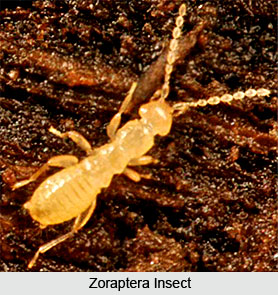 Zoraptera comprise the smallest insect order with only twenty five known species in a single genus. Most species have wingless individuals, which are blind and pale, as well as winged forms which are darker and possess eyes and ocelli. Rarely more than 2.5 millimetres long, with nine segmented bead-like antennae, they are found gregariously, in the warmer parts of the world under bark, near termite nests, or in rotting fallen logs and the like. Little is known of their habits, but they appear to be scavengers, though mites and fungal bodies have been found in their gut. Their developmental period is extremely protracted and, though they sometimes occur in colonies of more than hundred individuals and are polymorphic, no evidence of a social organization exists as in termites (Zorapterans also shed their wings after mating). Although there is considerable uncertainty regarding their nearest insect relatives, termites or psocids are thought to be the most likely candidates.
Zoraptera comprise the smallest insect order with only twenty five known species in a single genus. Most species have wingless individuals, which are blind and pale, as well as winged forms which are darker and possess eyes and ocelli. Rarely more than 2.5 millimetres long, with nine segmented bead-like antennae, they are found gregariously, in the warmer parts of the world under bark, near termite nests, or in rotting fallen logs and the like. Little is known of their habits, but they appear to be scavengers, though mites and fungal bodies have been found in their gut. Their developmental period is extremely protracted and, though they sometimes occur in colonies of more than hundred individuals and are polymorphic, no evidence of a social organization exists as in termites (Zorapterans also shed their wings after mating). Although there is considerable uncertainty regarding their nearest insect relatives, termites or psocids are thought to be the most likely candidates.
The Zorapterans possess chewing mouthparts and they feed on fungi and dead and small arthropods. Their eggs are very small, ovoid and pale. Nymphs bear simple metamorphosis and represent wingless and small adults as they grow by four growth stages, or instars. The Zorapterans are secretive and rare, so comparatively very less is known about their habits. The behaviour of these insects more or less resembles the termites, and they may possess an old social structure. Some of these species bear an elaborate pre-mating ritual in which the males release a liquid content from a gland which is in their head and they offer this to the female. Then only the females allow mating after getting this courtship gift and judging its quality.
The Zoological Survey of India was established in the year 1916 and its collections cover the whole of India. The Museums at Kolkata houses more than a million specimens belonging to all the animal groups from Protozoa to Mammalia. These collections are invaluable for research in the laboratory or in the field. Fourteen collecting stations are maintained in different ecological biotopes, such as the Desert Regional Station at Jodhpur and the High-altitude Station at Solan.



















